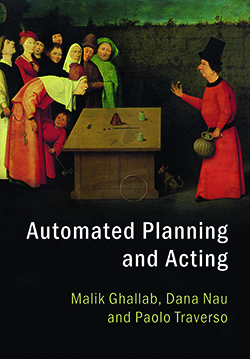 |

|
 |
Professor Dana Nau’s (CS/ISR) new book, Automated Planning and Acting, is defined by collaboration. The book reunites Nau with colleagues and co-authors Malik Ghallab (Laboratoire d'analyse et d'architecture des systems) and Paulo Traverso (FBK-ICT IRST), the trio that produced 2004’s Automated Planning, published by Morgan Kaufmann. Published by Cambridge University Press in August, and available in both hardcover and electronic versions, Automated Planning and Acting introduces "complex computational techniques for planning and performing actions" to graduate students and others interested in this area of artificial intelligence. Four years of collaborative work, and much lively discussion, went into the making of the book. The result is “a research roadmap,” said Nau. The three AI automation and planning experts decided to challenge a few suppositions in the AI planning community. One aspect of planning that Nau hopes readers especially notice is the need for the planning community to remember that all actions for an intelligent system take place in a dynamically changing world. It is difficult to assume perfect deterministic action when setting out to achieve an objective. The book, which includes problem sets, will be especially useful for graduate AI planning courses. The book also will give students a chance to learn a bit of art history, as they may spend time determining why the authors settled upon a Hieronymus Bosch painting, “The Conjurer,” as the cover art.
Synopsis
Autonomous AI systems need complex computational techniques for planning and performing actions. Planning and acting require significant deliberation because an intelligent system must coordinate and integrate these activities in order to act effectively in the real world. This book presents a comprehensive paradigm of planning and acting using the most recent and advanced automated-planning techniques. It explains the computational deliberation capabilities that allow an actor, whether physical or virtual, to reason about its actions, choose them, organize them purposefully, and act deliberately to achieve an objective. Useful for students, practitioners, and researchers, this book covers state-of-the-art planning techniques, acting techniques, and their integration which will allow readers to design intelligent systems that are able to act effectively in the real world. The book covers a wide range of different techniques, their pros and cons, and how they can be used effectively in different real-world applications. It presents state-of-the-art techniques for planning, and how to integrate these techniques with acting to design intelligent systems.
Reviews
“Automated Planning and Acting will be the text I require my students to read when they first start, and the go-to book on my shelf for my own reference. As a timely source of motivation for game-changing research on the integration of planning and acting, it will also help shape the field for the next decade." -- Sylvie Thiébaux, Australian National University, Canberra
"This book is currently the most comprehensive introduction [to] computational principles of deliberative action that I know of. Whoever thinks about bringing planning and reasoning to bear on robots or other agents embedded in the real world should study it carefully - and share it with their students too." -- Joachim Hertzberg, Osnabrück University
"This book by Ghallab, Nau and Traverso is the best to date on automated artificial intelligence planning. It is very comprehensive, covering topics both in the core of AI planning and acting and other related AI topics such as robotic execution, automation and learning. Numerous features make it ideal for students to learn about AI planning, including historical notes and many illustrative examples. The book will serve as a trove of resources for researchers and practitioners in AI planning and other AI fields." -- Qiang Yang, Chair Professor and Head of the Computer Science and Engineering Department, Hong Kong University of Science and Technology
Related Articles:
Alum Amnon Lotem promoted to Chief Technology Officer at Skybox Security
New Research Helps Robots Grasp Situational Context
ISR Alum Quoted in CNN, WSJ on AI Risks
Reinforcement learning is a game for Kaiqing Zhang
CSRankings places Maryland robotics at #10 in the U.S.
NSF funding to Fermüller, Muresanu, Shamma for musical instrument distance learning using AI
Two ECE Graduate Students Win 2023 UMD Three Minute Thesis Competition
Shneiderman: Faulty machine learning algorithms risk safety, threaten bias
UMD’s SeaDroneSim can generate simulated images and videos to help UAV systems recognize ‘objects of interest’ in the water
Fermüller and Muresanu VAIolin work featured in Maryland Today
September 29, 2016
|

